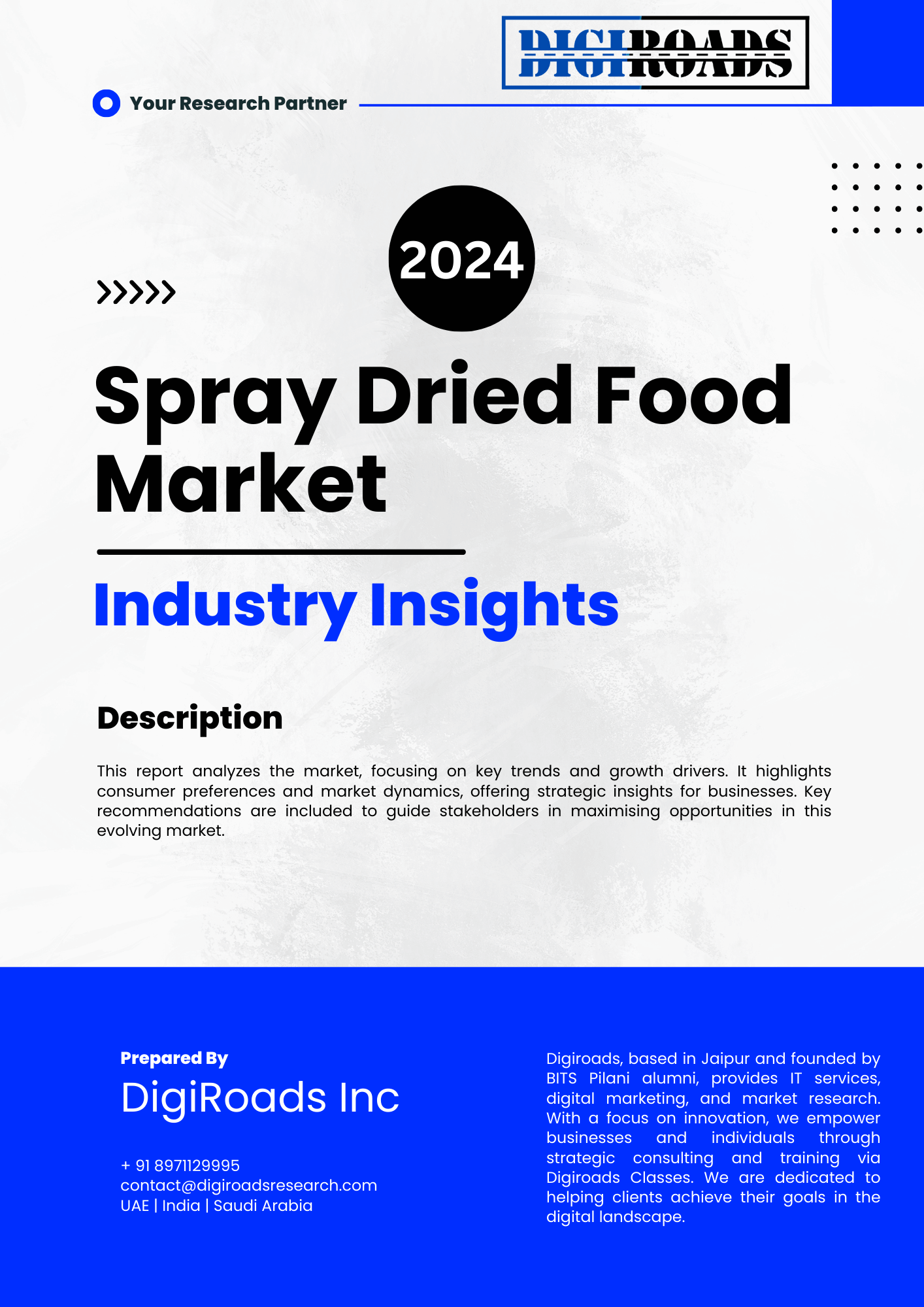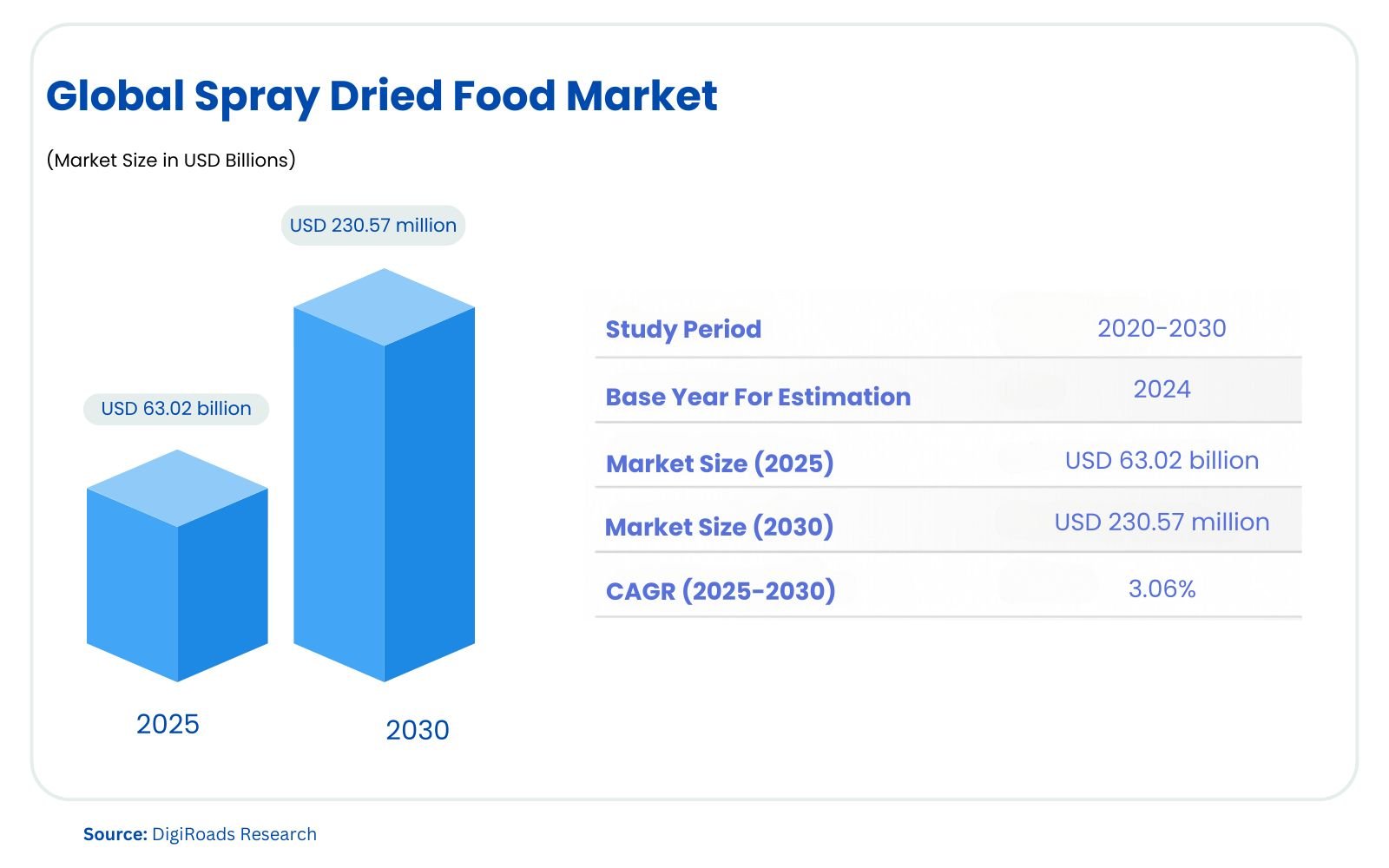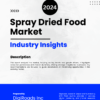Global Spray Dried Food Market
- Brand: DigiRoads
Explore the 100+ page report on the Global Spray Dried Food Market, offering insights into trends, growth drivers, and the competitive landscape. Available in PDF and Excel formats for convenient access to detailed data and analysis.
Global Spray Dried Food Market Report | Market Size, Industry Analysis, Growth Opportunities, & Forecast (2025-2030)
Global Spray Dried Food Market
The global spray dried food sales market is experiencing remarkable growth, with an estimated market size of USD 63.02 billion in 2025. It is projected to reach USD 85.89 billion by 2030, expanding at a robust CAGR of 6.36% during the forecast period 2025–2030. The global Spray Dried Food Market is projected to grow steadily from 2025 to 2030, driven by rising demand for convenient, long-lasting food products. Spray drying, a key preservation method, helps maintain the nutritional content of foods while extending their shelf life. The market is segmented into product types such as fruits, vegetables, dairy products, meat, fish, seafood, and spices. Application areas include infant foods, nutraceuticals, baked goods, ice cream, and pet foods.
The Asia-Pacific region is expected to register the highest growth during this period due to its expanding food industry and increasing consumption of processed foods. North America will continue to dominate, with a significant market share driven by consumer preferences for easy-to-use and shelf-stable food products. Key players in the market include Koninklijke DSM N.V., Fonterra Co-operative Group Limited, Kerry Inc., Givaudan, and Döhler GmbH, who are actively innovating and expanding their reach. As more consumers seek healthy, convenient food solutions, the demand for spray-dried food will continue to rise, presenting new opportunities for market players. This report provides an in-depth analysis of market trends, growth drivers, challenges, and future projections, offering valuable insights for stakeholders.
Market Report Coverage:
The “Global Spray Dried Food Market Report—Future (2025-2030)” by Digiroads Research & Consulting covers an in-depth analysis of the following segments in the market.
| By Product Type | Fruits, Vegetables, Dairy, Meat, Fish & Seafood, Spices, Others |
| By Application | Infant Foods, Nutraceuticals, Baked Goods, Ice-Cream, Pet Foods |
| By Geography | North America, Europe, Asia-Pacific, South America, Middle-East & Africa |
Study Assumptions and Definitions
This report on the Global Spray Dried Food Market covers the forecast period from 2025 to 2030. It assumes the continued growth of the food processing industry, with the spray drying technique being widely adopted across various product segments, including dairy, fruits, vegetables, and spices. The market is driven by increasing demand for convenience foods, longer shelf-life, and nutrient retention in food products.
Key assumptions for the market include steady economic growth, technological advancements in spray drying, and increasing consumer awareness of the benefits of processed foods. The forecast period accounts for factors such as regional economic conditions, advancements in food technology, and evolving consumer preferences for healthier, nutrient-preserved products.
Definitions used in the study include spray drying as a method of converting liquid or slurry forms of food into powders through rapid drying. Market segmentation includes categories such as product types (fruits, vegetables, dairy, meat, etc.), applications (infant foods, nutraceuticals, baked goods, etc.), and geographical regions (North America, Europe, Asia-Pacific, etc.). The market forecast considers these assumptions, with growth projections for 2025-2030.
Market Scope
The market scope of the Global Spray Dried Food Market for the forecast period 2025-2030 encompasses various product types, applications, and geographical regions. The report focuses on key product categories such as fruits, vegetables, dairy products, meat, fish and seafood, spices and seasonings, among others. It also examines the growing applications of spray-dried food in sectors like infant foods, nutraceuticals, baked goods, ice cream, and pet foods.
Geographically, the market is analyzed across five major regions: North America, Europe, Asia-Pacific, South America, and the Middle East & Africa. The scope includes both emerging and established markets, highlighting regional growth trends and opportunities.
The report also explores the impact of technological advancements in spray drying, evolving consumer preferences for convenience and shelf-stable foods, and the increasing demand for nutrient-preserved products. This comprehensive scope provides a holistic view of the spray-dried food industry and its expected developments over the 2025-2030 period.
MARKET OUTLOOK
Executive Summary
The global Spray Dried Food Market is projected to experience significant growth from 2025 to 2030, driven by an increasing demand for convenient, shelf-stable, and nutrient-preserved food products. Spray drying technology, which converts liquid food extracts into powdered form while maintaining essential nutrients, is becoming a critical innovation in the food industry. The market is expected to grow at a steady CAGR of 6.36% during the forecast period, with North America holding the largest market share in 2025. However, Asia-Pacific is set to witness the highest growth rate due to expanding urbanization, rising disposable incomes, and a growing preference for ready-to-eat and processed foods.
Key product segments in the market include fruits, vegetables, dairy products, meat, fish, seafood, and spices and seasonings, with the dairy products category holding a significant share. Additionally, spray-dried foods are increasingly being used in infant foods, nutraceuticals, baked goods, ice cream, and pet foods, indicating the versatile applications of this technology.
The market dynamics are influenced by several factors, including advancements in spray-drying technology, evolving consumer preferences for health-conscious and functional foods, and rising awareness of food preservation methods. However, challenges such as the high energy consumption of spray-drying equipment and fluctuations in raw material prices may pose constraints to market growth.
Prominent players such as Koninklijke DSM N.V., Fonterra Co-operative Group Limited, Kerry Inc., and Givaudan are key contributors to the market’s competitive landscape, focusing on product innovation and strategic partnerships to enhance market presence. Overall, the Spray Dried Food Market is poised for continued growth, with promising opportunities for both established players and new entrants.
COMPETITIVE LANDSCAPE
The Global Spray Dried Food Market is moderately fragmented, with regional and multinational players competing fiercely for market share.
Key Market Players
- Koninklijke DSM N.V.
- Fonterra Co-operative Group Limited
- Kerry Inc.
- Givaudan
- Döhler GmbH
- Nestle SA
- Kanegrade Ltd.
- Mevive International Food Ingredients
- Sensient Technologies Corporation
- CHR Hansen
Market Share Analysis
The Global Spray Dried Food Market is projected to witness significant growth during the forecast period (2025-2030). As of 2025, North America holds the largest market share, driven by increasing demand for convenience foods, nutraceuticals, and pet foods. The region’s well-established food processing infrastructure, along with a growing trend for shelf-stable, ready-to-eat products, contributes to its dominant position. Europe follows closely, with key players like Koninklijke DSM N.V., Kerry Inc., and Givaudan focusing on new product developments and regional expansion.
In Asia-Pacific, the market is expected to experience the highest CAGR due to increasing consumer demand for nutritious and value-added food products, particularly in countries like China and India. The rising health-conscious population and rapid urbanization are significant factors influencing this growth. Moreover, the demand for spray-dried ingredients in infant foods, baked goods, and ice cream in emerging markets is expanding.
Market players are focusing on technological advancements, such as improved spray-drying techniques, to enhance product quality and reduce operational costs. Partnerships and acquisitions are also common strategies to strengthen market positions. Overall, the Spray Dried Food Market is highly competitive, with players continuously innovating to maintain their market shares in both developed and emerging markets.
MARKET DYNAMICS
Market Drivers and Key Innovations
The Global Spray Dried Food Market is propelled by several key factors that are expected to drive growth from 2025 to 2030. One major driver is the growing demand for convenience foods. Spray drying helps extend the shelf life of food products, making them ideal for the busy, on-the-go consumer. This demand is especially prominent in nutraceuticals, baked goods, and infant foods, where consumers seek long-lasting, nutrient-preserved products.
Additionally, rising health awareness is encouraging consumers to adopt nutritious alternatives, which has contributed to the demand for spray-dried ingredients such as fruits, vegetables, and dairy products. The increasing preference for natural and organic foods further supports market expansion. The versatility of spray drying in preserving essential nutrients while offering ease of transportation is another key factor.
Key Innovations:
Technological advancements in spray-drying techniques have been pivotal in market growth. Companies are investing in state-of-the-art equipment that improves the drying process, reducing energy consumption while enhancing product quality. For example, innovations in porous sugar through spray drying, as introduced by Nestlé, allow for lower sugar content in food products without sacrificing taste.
Moreover, new spray-dried formulations are being developed to meet specific consumer needs, including customized textures, colors, and flavors. Innovations like high-quality, nutrient-preserving spray-dried powders made from exotic fruits and vegetables are becoming increasingly popular in both the food and nutraceutical sectors.
These innovations, alongside ongoing improvements in sustainability and efficiency, are expected to fuel further market growth and competitiveness during the forecast period.
Market Challenges
High Operational Costs:
- The spray-drying process involves significant energy consumption, which leads to high operational costs. This can impact the affordability and pricing of spray-dried products, especially for smaller manufacturers.
Complexity in Quality Control:
- Maintaining consistent product quality during the spray-drying process is challenging. Variations in temperature, humidity, and raw material quality can lead to differences in the final product, which can affect customer satisfaction.
Limited Availability of Raw Materials:
- The availability of raw materials, especially specific fruits, vegetables, and dairy products, can fluctuate due to seasonal variations or environmental factors. This may impact production capabilities and market supply.
Technological Barriers for Smaller Players:
- While large companies can afford to invest in advanced spray-drying technologies, smaller players may struggle with the high capital costs required for innovation and maintaining efficient production standards.
Health Concerns Regarding Additives:
- Some consumers remain wary of processed foods, including those with additives and preservatives. While spray-drying helps maintain nutrients, the use of certain additives may deter health-conscious consumers.
Sustainability and Environmental Impact:
- The environmental impact of energy-intensive spray-drying processes and waste management remains a concern, with increasing pressure on companies to adopt sustainable practices and reduce their carbon footprint.
Competition from Alternative Preservation Methods:
- Alternative methods, such as freeze-drying, vacuum-drying, and dehydration, are gaining traction. These methods may offer benefits in terms of maintaining better texture and flavor profiles, creating competition for spray-dried foods.
Market Opportunities
Rising Demand for Convenience Foods:
- With the increasing adoption of busy lifestyles, there is growing demand for convenience foods, including instant meals and ready-to-eat snacks. Spray-dried foods are ideal for such applications due to their longer shelf life and ease of use.
Expanding Health and Wellness Trends:
- As consumers prioritize health and wellness, there is an opportunity to develop spray-dried products that cater to this demand, such as low-fat, low-sugar, and high-protein options in categories like infant foods, nutraceuticals, and baked goods.
Growth in the Nutraceutical Industry:
- The rise in health consciousness and the aging population presents a significant opportunity for spray-dried nutraceutical products, such as vitamins, probiotics, and other dietary supplements, which are increasingly popular among consumers.
Technological Advancements in Spray Drying:
- The development of more energy-efficient and cost-effective spray-drying technologies presents an opportunity to reduce production costs and improve the quality of the end product, leading to wider adoption across food industries.
Expanding E-Commerce Channels:
- The growth of online grocery shopping and direct-to-consumer models provides a unique opportunity for spray-dried food manufacturers to tap into new customer segments and expand their distribution channels globally.
Emerging Markets Growth:
- The increasing disposable income and urbanization in emerging markets, especially in regions like Asia-Pacific, South America, and the Middle East, offer untapped opportunities for spray-dried food manufacturers to expand their market presence.
Sustainability and Clean Label Demands:
- There is a growing demand for sustainable food production methods and clean-label products. Manufacturers can capitalize on this trend by offering spray-dried foods that emphasize minimal processing and sustainable sourcing of raw materials.
RECENT STRATEGIES & DEVELOPMENTS IN THE MARKET
Expansion of Product Portfolio by Key Players:
- Koninklijke DSM N.V. and Fonterra Co-operative Group have been expanding their product portfolios by introducing new spray-dried dairy products and specialty ingredients, catering to increasing consumer demand for high-protein and dairy-based products. For example, Fonterra’s recent launch of plant-based spray-dried dairy alternatives targets the growing vegan food trend.
Adoption of Advanced Spray Drying Technology:
- Kerry Inc. has been investing in research to enhance spray drying technologies that ensure better retention of nutrients and flavor, leading to improved product quality. Their latest innovations focus on creating more energy-efficient spray-drying processes to reduce costs and environmental impact.
Strategic Acquisitions and Partnerships:
- Nestlé has acquired smaller companies that specialize in spray-dried food products, particularly in the infant nutrition and nutritional supplement sectors. These acquisitions allow Nestlé to strengthen its position in the spray-dried food market and expand its reach in emerging markets, such as Asia-Pacific.
Sustainability Initiatives:
- Givaudan has been focusing on sustainability in spray-dried food production, using renewable energy sources and sustainable raw materials. This is in line with the growing consumer demand for eco-friendly, sustainably sourced food products.
Geographical Expansion:
- Döhler GmbH has expanded its presence in the Asia-Pacific region by setting up new manufacturing facilities for spray-dried food products in China and India. This expansion is aimed at capitalizing on the region’s growing demand for processed food products.
Focus on Clean Label Products:
- Sensient Technologies Corporation and CHR Hansen are focusing on producing clean-label spray-dried products, offering food manufacturers natural and minimally processed ingredients. This aligns with the rising consumer preference for clean-label and transparent food products.
R&D and Product Innovation:
- McCormick & Company Inc. has been investing in R&D to develop spray-dried seasonings and flavoring products, providing convenience and longer shelf life to meet the demands of the growing foodservice and packaged food sectors.
Entry into Emerging Markets:
- Mevive International Food Ingredients has launched initiatives to introduce spray-dried food products in emerging markets, including the Middle East and Africa, capitalizing on the rising demand for convenience foods in these regions.
KEY BENEFITS FOR STAKEHOLDERS
Growth Opportunities:
- The forecasted growth in the spray-dried food market offers stakeholders opportunities to capitalize on expanding product demand, especially in regions like Asia-Pacific. This provides a favorable environment for increased sales and market share.
Enhanced Market Insights:
- Stakeholders gain a comprehensive understanding of market trends, competitive dynamics, and customer preferences, enabling them to make informed decisions regarding investments, product development, and marketing strategies.
Innovation and Product Differentiation:
- Stakeholders can leverage ongoing innovations in spray-drying technology and clean-label trends to differentiate their products, meeting consumer demand for high-quality, sustainable, and natural food options.
Strategic Expansion:
- Regional expansion, particularly into emerging markets such as India, China, and Brazil, offers stakeholders the opportunity to tap into growing food sectors and establish a strong market presence in these fast-developing regions.
Risk Mitigation:
- The ability to diversify product offerings (fruits, vegetables, dairy, etc.) across various applications such as infant foods, nutraceuticals, and baked goods helps stakeholders mitigate risks by catering to a wide range of industries.
Sustainability Initiatives:
- With growing emphasis on sustainability, stakeholders can benefit from aligning with eco-friendly and energy-efficient manufacturing processes, which enhance brand reputation and appeal to environmentally conscious consumers.
Increased Profitability:
- By adopting cost-effective and energy-efficient spray drying technologies, stakeholders can reduce production costs, leading to improved profitability while maintaining high product quality.
Stronger Competitive Position:
- Leveraging market trends like clean-label products and nutraceutical applications enables stakeholders to strengthen their position against competitors, fostering long-term growth and customer loyalty.
At DigiRoads Research, we emphasize reliability by employing robust market estimation and data validation methodologies. Our insights are further enhanced by our proprietary data forecasting model, which projects market growth trends up to 2030. This forward-thinking approach ensures our analysis not only captures the current market landscape but also anticipates future developments, equipping stakeholders with actionable foresight.
We go a step further by offering an exhaustive set of regional and country-level data points, supplemented by over 60 detailed charts at no additional cost. This commitment to transparency and accessibility allows stakeholders to gain a deep understanding of the industry’s structural and operational dynamics. By providing exclusive and hard-to-access data, DigiRoads Research empowers businesses to make informed strategic decisions with confidence.
In essence, our methodology and data delivery foster a collaborative and data-driven decision-making environment, enabling businesses to navigate industry challenges and capitalize on opportunities effectively.
Contact Us For More Inquiry.
Table of Contents
-
INTRODUCTION
- Market Overview
- Years Considered for Study
- Market Segmentation
- Study Assumptions and Definitions
- Market Scope
-
RESEARCH METHODOLOGY
-
MARKET OUTLOOK
- Executive Summary
- Market Snapshot
- Market Segments
- By Product Type:
- Fruits, Vegetables, Dairy, Meat, Fish & Seafood, Spices, Others
- By Application:
- Infant Foods, Nutraceuticals, Baked Goods, Ice-Cream, Pet Foods
- By Geography:
- North America, Europe, Asia-Pacific, South America, Middle-East & Africa
- By Product Type:
-
COMPETITIVE LANDSCAPE
- Recent Strategies (Key Strategic Moves)
- Market Share Analysis
- Company Profiles
- Koninklijke DSM N.V.
- Fonterra Co-operative Group Limited
- Kerry Inc.
- Givaudan
- Döhler GmbH
- Nestle SA
- Kanegrade Ltd.
- Mevive International Food Ingredients
- Sensient Technologies Corporation
- CHR Hansen
-
MARKET DYNAMICS
- Market Drivers
- Market Challenges
- Market Opportunities
- Porter’s Five Forces’ Analysis
- Bargaining Power of Suppliers
- Bargaining Power of Buyers
- Threat of New Entrant
- Threat of Substitutes
- Competitive Rivalry
-
GLOSSARY OF PROMINENT SECONDARY SOURCES
-
DISCLAIMER
-
ABOUT US



